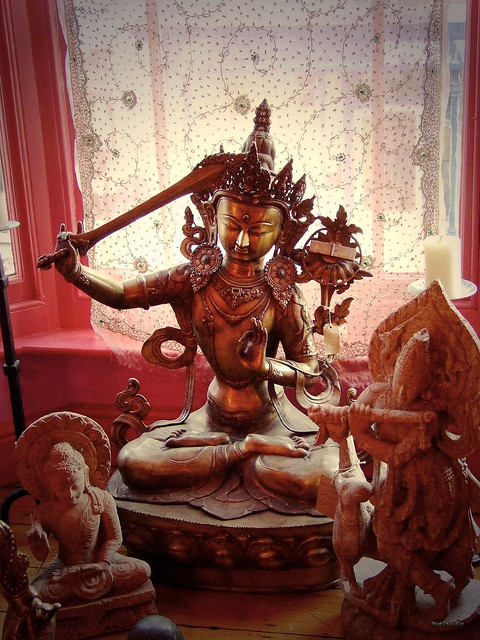
by user_dd | Feb 7, 2022 | Community Conversations
Snakes are misunderstood. They are often villainized and characterized as threatening, scary, even evil. Sure, some of them are poisonous; it’s wise to keep a wide berth if you find yourself moseying about with a venomous snake. However, can we take a moment to suspend our survival instincts and take a humbling look at the symbolism of snakes?
Why is it that the snake has earned such a prominent role in mythology, symbolism and sacred scripture?
Growth isn’t always comfortable, folks. Despite (or perhaps because) of any resistance, let’s take a look at one of those frightening symbols that so many shy away from (perhaps, by design).
East Meets West
First, let’s acknowledge the Eastern perspective of snakes, as represented in the ancient Hindu texts. The Sanskrit word ‘Kundalini’ translates to a ‘coiled snake’ of divine feminine energy that is believed to be located at the base of the spine, within each human body. Within the Vedas, there are different practices and modalities described to ‘awaken’ this energy and encourage the flow of energy to move up the spine.
Now let’s look at Western serpent symbology, within the context of the Garden of Eden. Remember this terrestrial paradise depicted in the Genesis story? Well, for anyone who needs a biblical refresh, there was a beautiful garden filled with all of the bountiful gifts on the Earthly plane. Adam and Eve explored the garden, and were met by a serpent who encouraged them to eat the fruit that God had explicitly forbidden them to eat. Verbally seduced into eating the fruit off the Tree of Knowledge, Adam and Eve were banished from the garden at the cost of their hunger for God-like awareness of good and evil.
Their inability to resist the physical temptations meant that Adam and Eve were relegated to eternal damnation in hell. Rough hand, right? Well, if accurately interpreted, we can see this as an invitation to come into a better relationship with our own inner serpent, so we’re not dancing with danger in the biblical sense. If scripture is providing an allegory that can be decoded for our modern application, how do we transform this information to aid us in our spiritual journey?
Bridge to a New Reality
Now, let’s dive into the middle way, where East meets West, shall we? What does it mean for us to acknowledge the snake that dwells within us? Forget the deceptive serpentine seductress in the Garden of Eden; look inside and try to find that part of you that has innate access to our own divinity.
What if you were the apple of your own eye, able to feast on the fruits of your own inner garden? This feast requires work, dear friends; we must plant healthy seeds, tend to them properly and lovingly, and practice patience as the cultivation process occurs.
The snake provides a path to transformation, and let’s face it, transformation isn’t always easy. Sometimes we have to face the scary, we have to taste our own medicine. Snakes possess both the venom and the antivenom; we, too, contain both the ingredients for our own demise and self-sabotage, as well as the ingredients for our own transformation and blossoming.
The spiritual journey is not always a smooth, well paved road. There are often bumps and detours along the transformational path, and it’s imperative that we cultivate the adaptability, the resilience, and the adept grace to forge on when the going gets tough. When something triggers fear in you, let it serve as a growth indicator; that which we are fearful of can usually provide an opportunity for transformation.
Entering this path of transformation is usually prompted by one’s own intuitive calling. So, if you’ve heard the call and wish to jump into the driver’s seat of your life, join us for our upcoming Spiritual Intuition class, where we’ll apply a lot of this knowledge to amplify our God-like gifts!

by user_dd | Oct 19, 2015 | Community Conversations
Most of what you’ve been hearing about Tantric sex is false.
Or rather, it’s not the whole picture…
GETTING TAN-TRICKED
In the West, with the New Age and personal development movements growing, there’s been a lot of talk about spiritual life. Yoga studios are all over, the Law of Attraction is a buzzword, and meditation is starting to be taught in schools and businesses. One of our most powerful urges is also shining in the indigo spotlight—sex.
In an attempt to spiritualize sex, we have taken an age-old practice and adopted it for our own desires. Countless books and videos claim to teach Tantra, which is said to be a practice that deepens sexuality and takes it to new levels. While there is nothing wrong with trying to enhance your relationship with your partner, it’s important to honor the genuine message of Tantra if its name is to be invoked.
A CLOSER LOOK
Tantra evolved from the Vedic tradition of India, an ancient spiritual doctrine that some believe originated 7000 years ago. The word Tantra, depending on who you ask, means technique, ritual, or expansion—we can say that it is a practical method for spiritual development. It often employs gestures, chants, visualizations, postures, and movements.
What distinguishes Tantra is the acknowledgement of both the masculine and feminine principles that constitute reality. In some ways, this is similar to the Taoist concept of Yin and Yang. Some Tantriks call these principles Shiva—the god, representing universal consciousness—and Shakti—the goddess, representing energy and matter. Tantra is a nondual philosophy, believing that all of existence is Divine, and that the physical and transcendent are merely two aspects of one, indivisible whole.
This leads to the second quality that distinguishes Tantra: it sees the mundane as having ripe potential in spiritual development. In other words, the energies that are spent and generated in daily life can be redirected for attaining Enlightenment. The Hindu mystic, Sadhguru, explains more:
The simple principle of tantra yoga is: whatever can take you down can also take you up…tantra is about building our energies to the fountain-head of the uppermost dimension of the energy system, so that one’s energies spill from the top.
THE ROLE OF SEX
Sexuality can play a role in Tantra, however, it’s role isn’t what Westerners often depict it. In one sense, the relationship between the Guru and the disciple can be very intimate, and ignite orgasmic, ecstatic states. It is said that Lord Krishna simultaneously gave 16,000 women orgasms. This type of orgasm, though, goes beyond sexuality and is not even physical. It is the opening of barriers to greater consciousness in the disciple, and the closest experience many of us have to relate to that is sexual orgasm.
Sexual energy can also be transmuted into more rarified forms that accelerate an initiate’s evolution. This is also a practice in Taoist Inner Alchemy, which requires significant discipline and training to master. There are certain schools that allow physical intimacy in the process of sexual transmutation, and advocate that such work dramatically deepens intimacy. Yet even these schools acknowledge that there are much more advanced levels. These involve having “sex” with the polarities within yourself, and even “making love” to the Cosmos. Upon reaching these levels, physical sex may feel superfluous.
MORE THAN A FEELING
Tantra is definitely a rich field of intense spiritual work. It is not synonymous with spiritual sex, for it encompasses so much, and it does not promote spicing up your life with exotic sex postures. Kundalini yoga, Hatha yoga, mudras, mantras, and ritual dancing all can be considered forms of Tantra. One could even go so far as to say that mindfulness in brushing your teeth, transforming your anger into ecstasy, or simply feeling the Divine Spirit in every rock and dumpster are all nods to Tantra.
It’s not uncommon for Eastern traditions to be misunderstood in the West, even with good intentions. Knowing that Tantra is not strictly about sex, it might also be worth pointing out that there are ways to introduce sexuality into your spiritual growth. It’s not a sin!
Below are some resources for leading you in the right direction, if you feel called. Remember, though, that sex is only one of the many aspects of the human experience, and that if you are very serious about your spiritual development, you may one day reach the point where you will re-evaluate the importance of sex in your life.
RESOURCES
- http://mantakchia.com/immortal-inner-alchemy-teachings-master-mantak-chia/
- http://www.healingtaousa.com/isa.html
- http://www.tantra-kundalini.com/
Please share your honest responses. No judgment—promise! What role does sex currently play in your life? Has it propelled you to greater heights? If so, how?



